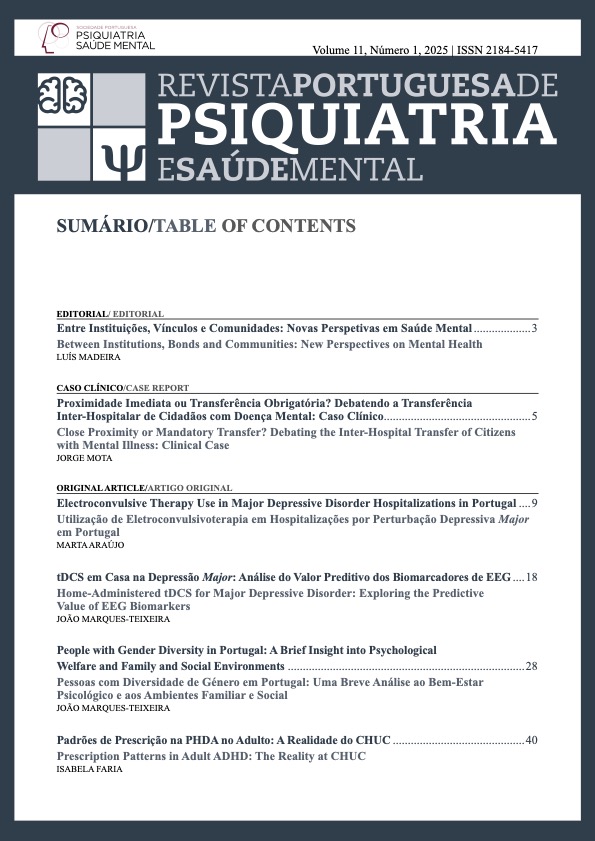Electroconvulsive Therapy Use in Major Depressive Disorder Hospitalizations in Portugal
DOI:
https://doi.org/10.51338/rppsm.553Keywords:
Depressive Disorder, Major/therapy, Electroconvulsive Therapy, HospitalizationAbstract
Introduction: Depression, recognized as a major contributor to global disability, requires diverse therapeutic strategies. While psychological therapy and antidepressant medications are primary interventions, electroconvulsive therapy (ECT) emerges as a valuable option for severe and treatment ‑resistant cases. This retrospective observational study explores the scenery of depressive disorder‑related hospitalizations in Portuguese public hospitals from 2008 to 2015.Methods: Utilizing administrative data provided by Administração Central do Sistema de Saúde I.P. (ACSS), hospitalizations with primary depression diagnoses were examined. Therefore, all hospitalizations from patients aged 18 or older with a primary diagnosis of depression, selected by International Classification of Diseases, Ninth Revision, Clinical Modification (ICD ‑9 ‑CM) codes 296.2x to 296.3x (Major depressive disorder), 300.4 (Dysthymic disorder) and 311 (Depressive disorder, not elsewhere classified) were included.
Results: Over the study period, 32 648 hospitalizations with primary depression diagnoses were identified. Major depressive disorder recurrent episodes dominated ECT procedures (72.6%), with only 2.8% of depression hospitalizations having received ECT in the last year. A linear increase in ECT cases from 2010 to 2015 was observed, coinciding with a decline in total depressive disorder ‑related hospitalizations. A higher proportion of men received ECT compared to women. The mean age of ECT recipients was significantly lower.
Discussion: The study’s findings demonstrate an underuse of ECT procedures in depression hospitalizations in Portugal. The observed increase in ECT utilization in the study period may indicate evolving perceptions and improved accessibility.
Conclusion: Depressive disorders constitute a significant portion of psychiatric hospitalizations in Portugal. This study contributes to understanding ECT use in Portugal.
Downloads
References
World Health Organization. Depressive disorder (depression). Geneve: WHO; 2023.
Curran C, Knapp M, McDaid D, Tómasson K. Mental health and employment: An overview of patterns and policies across Western Europe. J Mental Health. 2007;16:195-209.
GBD 2017 DALYs and HALE Collaborators. Global, regional, and national disability-adjusted life-years (DALYs) for 359 diseases and injuries and healthy life expectancy (HALE) for 195 countries and territories, 1990-2017: a systematic analysis for the Global Burden of Disease Study 2017. Lancet. 2018;392:1859-922.
Citrome L, Jain R, Tung A, Landsman-Blumberg PB, Kramer K, Ali S. Prevalence, treatment patterns, and stay characteristics associated with hospitalizations for major depressive disorder. J Affect Disord. 2019;249:378-84.
Leiknes KA, Jarosh-von Schweder L, Hoie B. Contemporary use and practice of electroconvulsive therapy worldwide. Brain Behav. 2012;2:283-344.
National Institute for Health and Care Excellence. Depression in adults: treatment and management. London: NICE; 2022.
Kennedy SH, Lam RW, McIntyre RS, Tourjman SV, Bhat V, Biler P, et al. Canadian Network for Mood and Anxiety Treatments (CANMAT) 2016 Clinical Guidelines for the Management of Adults with Major Depressive Disorder: Section 3. Pharmacological Treatments. Can J Psychiatry. 2016;61:540-60.
Milev RV, Giacobbe P, Kennedy SH, Blumberger DM, Daskalakis ZJ, Downar J, et al. Canadian Network for Mood and Anxiety Treatments (CANMAT) 2016 Clinical Guidelines for the Management of Adults with Major Depressive Disorder: Section 4. Neurostimulation Treatments. Can J Psychiatry. 2016;61:561-75.
Thirthalli J, Sinha P, Sreeraj VS. Clinical Practice Guidelines for the Use of Electroconvulsive Therapy. Indian J Psychiatry. 2023;65:258-69.
Mota J. Um pouco mais de luz—explicando o eletrochoque; vol 1. Porto: UPorto Edições; 2019.
Gangadhar BN, Kapur RL, Kalyanasundaram S. Comparison of electroconvulsive therapy with imipramine in endogenous depression: a double blind study. Br J Psychiatry. 1982;141:367-71.
Fink M. Convulsive therapy: a review of the first 55 years. J Affect Disord. 2001;63:1-15.
Baghai TC, Moller HJ. Electroconvulsive therapy and its different indications. Dialogues Clin Neurosci. 2008;10:105-17.
Jaffe R. The Practice of Electroconvulsive Therapy: Recommendations for Treatment, Training, and Privileging: A Task Force Report of the American Psychiatric Association, 2nd ed. Am J Psychiatry. 2002;159:1-331.
Mota P, Gonçalves-Pinho M, Ribeiro JP, Macedo S, Freitas A, Mota J. Electroconvulsive Therapy Use in Psychiatric Hospitalizations in Portugal: A Nationwide Descriptive Study. J ECT. 2021;37:270-3.
Benchimol El, Smeeth L, Guttmann A, Harron K, Moher D, Petersen I, et al. The REporting of studies Conducted using Observational Routinely-collected health Data (RECORD) statement. PLoS Med. 2015;12:e1001885.
Goncalves-Pinho M, Ribeiro JP, Fernandes L, Freitas A. Depressive Disorder Related Hospitalizations in Portugal Between 2008-2015: a Nationwide Observational Study. Psychiatr Q. 2022;93:791-802.
Goncalves-Pinho M, Freitas A, von Doellinger O, Ribeiro JP. Bipolar Disorder Related Hospitalizations - a Descriptive Nationwide Study Using a Big Data Approach. Psychiatr Q. 2022;93:325-33.
Agency for Healthcare Research and Quality. Clinical Classification Software-DIAGNOSES.
Quan H, Sundararajan V, Halfon P, Fong A, Burnand B, Luthi JC, et al. Coding algorithms for defining co-morbidities in ICD-9-CM and ICD-10 administrative data. Med Care. 2005;43:1130-9.
Kellner CH, Greenberg RM, Murrough JW, Bryson EO, Briggs MC, Pasculil RM. ECT in Treatment-Resistant Depression. Am J Psychiatry. 2012;169:1238-44.
Olfson M, Marcus S, Sackeim HA, Thompson J, Pincus HA. Use of ECT for the inpatient treatment of recurrent major depression. Am J Psychiatry. 1998;155:22-9.
Case BG, Bertollo DN, Laska EM, Price LH, Siegel CE, Olfson M, et al. Declining use of electroconvulsive therapy in United States general hospitals. Biol Psychiatry. 2013;73:119-26.
Almeida J, Xavier M, Cardoso G, Goncalves Pereira M, Gusmao R, Barahona Correa B, et al. Estudo Epidemiologico Nacional de Saude Mental. Lisboa: Faculdade de Ciencias Medicas, Universidade Nova de Lisboa; 2013.
Blanken M, Oudega ML, Hoogendoorn AW, Sonnenberg CS, Rhebergen D, Klumpers UM, et al. Sex-specifics of ECT outcome. J Affect Disord. 2023;326:243-8.
Guney P, Ekman CJ, Hammar A, Heintz E, Landen M, Lundberg J, et al. Electroconvulsive therapy in depression: improvement in quality of life depending on age and sex. J ECT. 2020;36:242-6.
Brus O, Nordanskog P, Bave U, Cao Y, Hammar A, Landen M, et al. Subjective memory immediately following electroconvulsive therapy. J ECT. 2017;33:96-103.
Torring N, Sanghani SN, Petrides G, Kellner CH, Ostergaard SD. The mortality rate of electroconvulsive therapy: a systematic review and pooled analysis. Acta Psychiatr Scand. 2017;135:388-97.








